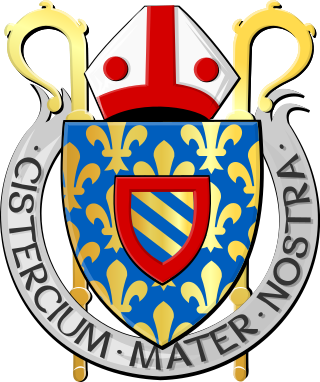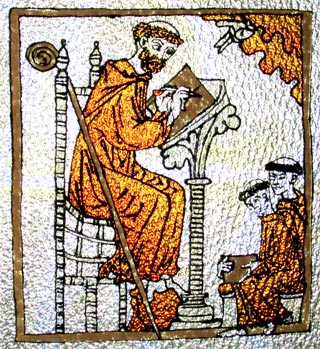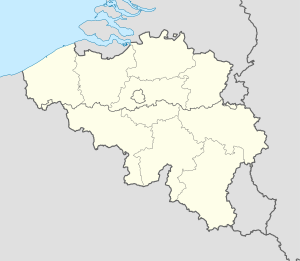
Clairvaux Abbey was a Cistercian monastery in Ville-sous-la-Ferté, 15 kilometres (9.3 mi) from Bar-sur-Aube. The abbey was founded in 1115 by Bernard of Clairvaux. As a primary abbey, it was one of the most significant monasteries in the order. Dissolved during the French Revolution, it was used from 1808 to 2023 as Clairvaux Prison, a high-security correctional facility. As of 2024, work is in process to make the space available and attractive to tourists.

Cîteaux Abbey is a Catholic abbey located in Saint-Nicolas-lès-Cîteaux, south of Dijon, France. It is notable for being the original house of the Order of Cistercians. Today, it belongs to the Trappists.

The Cistercians, officially the Order of Cistercians, are a Catholic religious order of monks and nuns that branched off from the Benedictines and follow the Rule of Saint Benedict, as well as the contributions of the highly-influential Bernard of Clairvaux, known as the Latin Rule. They are also known as Bernardines, after Saint Bernard, or as White Monks, in reference to the colour of their cowl, as opposed to the black cowl worn by Benedictines.

The Trappists, officially known as the Order of Cistercians of the Strict Observance and originally named the Order of Reformed Cistercians of Our Lady of La Trappe, are a Catholic religious order of cloistered monastics that branched off from the Cistercians. They follow the Rule of Saint Benedict and have communities of both monks and nuns that are known as Trappists and Trappistines, respectively. They are named after La Trappe Abbey, the monastery from which the movement and religious order originated. The movement began with the reforms that Abbot Armand Jean le Bouthillier de Rancé introduced in 1664, later leading to the creation of Trappist congregations, and eventually the formal constitution as a separate religious order in 1892.

Villers Abbey is a former Cistercian abbey located in the town of Villers-la-Ville, Walloon Brabant, Belgium. Founded in 1146, the abbey was abandoned in 1796. Most of the site has since fallen into ruins. These ruins now belong to the Walloon Region and are classified as part of Wallonia's Major Heritage.

Casamari Abbey is a Cistercian abbey in the Province of Frosinone, Lazio, Italy, about 10 kilometers east-south-east of Veroli.

The Abbey of Fontenay is a former Cistercian abbey located in the commune of Marmagne, near Montbard, in the département of Côte-d'Or in France. It was founded by Saint Bernard of Clairvaux in 1118, and built in the Romanesque style. It is one of the oldest and most complete Cistercian abbeys in Europe, and became a UNESCO World Heritage Site in 1981. Of the original complex comprising church, dormitory, cloister, chapter house, caldarium, refectory, dovecote and forge, all remain intact except the refectory and are well maintained. The Abbey of Fontenay, along with other Cistercian abbeys, forms a connecting link between Romanesque and Gothic architecture.

Cistercian nuns are female members of the Cistercian Order, a religious order of the Catholic Church.

Grandselve Abbey was a Cistercian monastery in south-west France, at Bouillac, Tarn-et-Garonne. It was one of the most important Cistercian abbeys in the south of France.

Vaux-de-Cernay Abbey is a former Cistercian monastery in northern France (Île-de-France), situated in Cernay-la-Ville, in the Diocese of Versailles, Yvelines. The abbey was abandoned during the French Revolution and fell into partial ruin. Most of the buildings, except for the church, were restored in the late 19th century by Charlotte de Rothschild, and the property is now a hotel.

Molesme Abbey was a well-known Benedictine monastery in Molesme, in Laignes, Côte-d'Or, Duchy of Burgundy, on the border of the Dioceses of Langres and Troyes.

Melleray Abbey was a Cistercian monastery, founded about the year 1134. It was situated in La Meilleraye-de-Bretagne in the vicinity of Châteaubriant in Brittany, in the present Loire-Atlantique, France, and in the Diocese of Nantes. Between 1817 and 2016 it was a house of Trappist monks. Since 2016 it has been used by the Chemin Neuf Community.

Aulps Abbey is a former Cistercian monastery located at an altitude of 810 metres in the village of Saint-Jean-d'Aulps in the Aulps Valley, Haute-Savoie, French Alps. It is 7 km from Morzine, 25 km from Thonon and 60 km from Geneva.

Cambron Abbey was a Cistercian abbey in Cambron-Casteau, in the municipality of Brugelette, Hainaut, Belgium. It was located on the river Blanche, a tributary of the Dender, about 9 km (5.6 mi) to the south-east of Ath. Dissolved in 1782, parts of the abbey still survive as ruins within Pairi Daiza zoo and botanical garden.

Igny Abbey or Val d'Igny Abbey is a Cistercian abbey located in Arcis-le-Ponsart, Marne, France. It was founded in 1128 for Cistercian monks, dissolved in 1791 during the French Revolution, re-established in 1876 for Trappist monks, destroyed in 1918, reopened in 1929 for Trappist nuns and modernised in 2008–12 to accommodate three or four pre-existing communities.

Guerric of Igny was a Cistercian abbot. Little is known about his early life. He may have been educated at Tournai's cathedral school, perhaps under Benedictine monk, Odo of Cambrai. Guerric appears to have lived a life of prayer and study near the Tournai Cathedral. His monastic formation was directly influenced by Bernard of Clairvaux, who praises him in several letters. In 1138, he became abbot of Igny Abbey, in the diocese of Rheims, a house dependent on Clairvaux. Here Guerric ruled as abbot until his death on 19 August 1157. It was here that he composed the 54 liturgical sermons that constitute his surviving works.

The Abbey of Saint-Sauveur-le-Vicomte, located in the commune of Saint-Sauveur-le-Vicomte in the Manche department of France, was a Benedictine monastery founded in the 11th century by Néel de Néhou, Vicomte of Saint-Sauveur. The abbey has longstanding connections with the nearby Channel Islands. After being dissolved in the French Revolution it became in the 1830s the mother house of the Sisters of Christian Schools of Mercy, now the Congregation of Saint Marie-Madeleine Postel.

Villeneuve Abbey, dedicated to Our Lady, was a Cistercian monastery at the present-day Les Sorinières, near Nantes in Pays de la Loire, France, founded in 1201 and dissolved in 1790, during the French Revolution.

Les Écharlis Abbey is a former Cistercian monastery in Villefranche, Yonne, France. It was founded in the 12th century by a secular priest with two companions who wanted to live a monastic life. Soon afterward, the monastery joined the Cistercian order as a dependency of Fontenay Abbey.



















